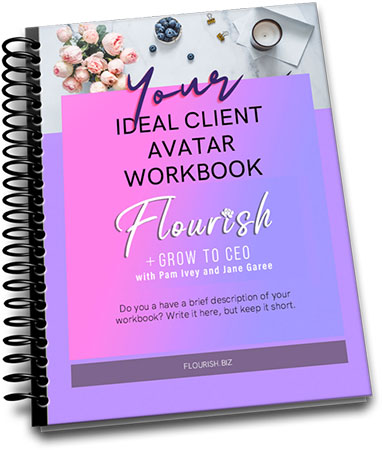Pam Ivey: You’re listening to the flourish and grow to CEO podcast. This is episode five.
Pam Ivey: Are you a lady boss making 50 to a hundred thousand in your business? And you’re ready to break through that six figure barrier.
Jane Garee: Have you done a great job of creating a nice life as the ultimate gig master, but no, your inner CEO is calling you to greater Heights. You’re in the right place. If you want to create and implement solid fundamentals in your business without sacrificing fun.
Pam Ivey: I’m Pam Ivey, I’m certified in small business management and I concentrate in the areas of training and certifying real estate assistance, coaching and mentoring entrepreneurs in online business, marketing growth and profit acceleration. And I take men and women business owners aged 40 plus to bucket list destinations around the world for a month at a time to work, explore, and live in community.
Jane Garee: And I’m Jane, Gary known as the sales strategist for the non sales person. And I work with business owners who want to increase their conversion rate, shorten their sales cycle and have more impact and influence with the work they do all while having more fun with selling,
Pam Ivey: Hey everyone, and welcome back to flourish and grow to CEO. The podcast today, we’re going to talk to you about branding and messaging and marketing. And these are a couple of areas that people groan about, but there’s so important that we nail in order to move our business forward and to grow. So I first wanted to talk a little bit about branding because people often mistake branding for the visuals, the logo and the colors, and people want to dive in right, and play with colors and play with different typography or fonts. But we have to really understand and get that branding is really the space that you occupy in your clients and your prospective client’s mind. It’s what people think about when the name of your company is said. So that’s really branding. It’s your personality. And it’s what you want people to think when people say your company name, does that sound good? Jane, do you think that’s nice and clear?
Jane Garee: Yeah, I think that’s perfect. I know branding can get so confusing for a lot of, there are a lot of different facets to it, but absolutely branding should just be the feeling this thought of the feelings somebody knows they can experience with when they work with you or your company. Yeah.
Pam Ivey: I think you brought up an excellent point too, cause it’s definitely the feeling that people have when they think of you too. And when we really are able to develop our personality, our brand personality and, you know, develop the thought that we have, we want to have in our perspective and our clients’ minds, we’re really able to envelop our messaging.
Jane Garee: Yeah. And the messaging piece is really important. So the branding and the messaging, those have to be really on point. And that is what gives people, that feeling of security because they know what they can expect from working with you.
Pam Ivey: So can you give us some examples maybe of messaging?
Jane Garee: A lot of people confuse messaging and they think it’s just something you’ve slapdash put together and shoot out there. And the messaging is really one of the most critical components of your entire business model and particularly of your brand. And here’s why when a message is on point, it will very naturally. And by naturally it’s the end result, or you have to be strategic to get to the natural. But when a message is on point, it will have recognition and resonance for your ideal clients. So let me jump into that a little bit further. So the recognition means they’re able to realize, they’re able to recognize that, Hey, where’s this person been my whole life. This is why I need their services. That’s what I need to get, where I want to be. So there’s a point of recognition where they know that they need you and you’re going to be a good fit.
Jane Garee: The problem that they have is probably able to be solved by the solution that you’re offering. So that’s the point of recognition which should show up in your messaging. There’s also the point of resonance and resonance is more the feel the resonance is, Oh, I feel like this person gets me. I feel like this person understands the challenges and the struggles that I’ve had. I really feel like this person would resonate with what I’m doing and what I want to do and where I want to be with my business and my life. So messaging has got to be so dialed in that when your ideal clients read it or hear it or experience it in any medium from you and your company, they recognize and resonate with it. Without those two things happening as a result of your spot on message, it’s going to be really challenging to get clients. And that’s because you’re going to get caught in the noise. You’re going to get stuck and sound like everybody else. And it’s just not something that’s going to be compelling. So messaging, messaging, messaging, you really want to pay a lot of attention and time to
Pam Ivey: Exactly. And you know, our, we start with our messaging, cause you’re saying we want people to say, Oh my God, it’s like, she knows me. Or she gets me or you took the words right out of my mouth. We really have to understand our ideal client avatar. And I know that people struggle with this because they say, Oh my goodness done this. I know who my ideal client is. But oftentimes, you know, what we hear is when we say, who’s your ideal client, they’ll say I work with women who own a business and are stuck,
Jane Garee: Right? Yeah. It’s just not clear enough messaging. And you really want to think about what are your ideal clients? What are their problems? What are their challenges? What are they sick and tired of dealing with? What do they no longer want to have in their life? What do they want to let go of? What do they wish worked as it were? And on the flip side, what do they most want? What do they dream of? What do they hope for? I call it the 2:00 AM in the middle of the night problem. When they’re in bed at two o’clock in the morning, in the middle of the night and they can’t sleep, what are they saying to themselves? And this tripped up because they know from a different level and from a different vantage point, what their ideal clients need and want. But here’s the thing, your ideal clients almost never know what they really, really need and what they really really want. It’s almost kind of like a surface level. I want more money. I want more time. I want this business to be successful and that’s good. That’s a start for your messaging. But in the messaging, you need to dig deeper to figure out what is the underlying root problem or desire they have from all of that. So two o’clock in the morning, you want to think in terms of their mind, what are they saying to themselves in the dark when nobody else can hear them? That’s okay.
Pam Ivey: Important one, what is the self-talk that’s going on in their head? What would the ultimate vision be of what they want their life to look like? Because a business as part of your life. So somehow can you help them get there? There’s so many questions that you need answers to. And I’m thinking Jane, what we’ll do is in our show notes for this episode, we’ll include a list of those questions that you should be asking to really hone in on who your ideal client is. I think it’ll be most helpful. We’ve totally done it. Jane and I have done it. So it’s very detailed and Oh, what are the best ways I want to let people in on this secret is to interview your ideal client or the clients that you love to work with. Let’s start there. So your current clients or past clients that you absolutely adored working with, talk to them, ask them these questions that we’re going to give to you in the show notes and what you’ll get. Not only you’ll get a clearer view of who your ideal client is, but you’ll get their language, how they describe what their problems and their hopes and their dreams are. When you use that in your marketing. That’s how you seriously resonate with your ideal client.
Jane Garee: Yeah. Their language is that’s the ticket there. It’s not your language, it’s their language.
Pam Ivey: So of course, we’re going to delve much further into the branding and messaging side of our businesses with amazing experts that we have come on to the show in upcoming episodes. How about we talk about marketing and I know Jane is rolling her eyes, cause it’s not her favorite topic, but it’s one that’s mine. So I’m so excited to talk about it.
Jane Garee: Well, as you know, over the years, I haven’t embraced marketing. So for some of you, if you’re listening right now and you’re thinking, woo, let’s get into marketing and I love it. And you’re like, Pam, that’s great. I’m not talking to you. I’m talking to all the other people right now, like me who go marketing. And it’s just the bane of my existence. I know it has to be done, but I don’t really love doing it. So hopefully we are going to give you some clarity today on what marketing actually is and how you can turn it from something you just can’t stand the thought of doing to something that actually
Pam Ivey: Pretty fun. And it can be fun. And I think why a lot of people don’t like marketing quote unquote, or it overwhelms them so much is because there’s always a new marketing flavor of the day. I like to call it. There’s a new tactic. Remember we were talking about strategy and tactics. We need to have our overall strategy first. And part of that is knowing who your ideal client is, where they hang out, where they get their information from who else they listen to. And it can really hone in on what tactics you use to achieve the overall vision, you know, with your strategy. So going back to fundamentals, then we’re gonna really concentrate on what’s called the ATUs model. That’s a, I D a S and that’s for attract like attracting attention to your business, maintaining interest, creating desire for what you have to sell people, taking action.
Pam Ivey: So they’re actually buying what you’re selling and afterwards to satisfy customers because that results in repeat business and recommendations and testimonials. So we can have more business. Here’s an example. Let’s put it into something that you can relate to. Let’s say you’ve structured your website around the ADA model. And you’re going to use, let’s say content marketing to drive people to your site in your content. You can drag their attention and deeply engaged with them. Your target audience will start to become curious about what your company actually does. So in this stage, the attract attention, the customer is asking, what is it in order to get to this stage? You’ve got to first get your content in front of them. And this comes with increased brand awareness and effective messaging. What we were talking about before. So for example, effective content marketing is one method of attracting visitors to your website.
Pam Ivey: If you create content that solves their problems and focuses on their passions, you’ll be able to draw them in and provide a solution. When executed effectively, your target audience should be able to discover your content through Google, social media and other channels that you decide that you want to use. Because, you know, as a side note, doing your homework on your ideal client, avatar, where they hang out. So our next step in ADAS is to generate interest. Once your target audience is interested in your product or service, they’ll want to learn more about your brand, the benefits of your solution and your potential fit with them in this stage. The goal is to get them to think I like it in order to get to this stage, your content has got to be persuasive and engaging. Well, the first stage of ADA is capturing their attention. This stage is about holding it. So you can do this with a hook. For example, let’s say your content marketing was effective and drawing them into your website to learn about a pain, a problem, or a need. They have, you might then quote unquote, hook them with engaging storytelling that demonstrates the why behind your solution. Stories really resonate with humans. And it’s a simple way to convey information in a way that stimulates empathy and curiosity. Jane is a masterful storyteller, and you really use this well to draw people into your brand.
Jane Garee: Yeah. Storytelling is actually, we were wired to tell stories back in the, okay, can I history geek out for a little minute here? Oh yeah, absolutely. James loves history. So back in the day, since the Dawn of time, we really have been storytellers because there was no such thing as the internet. There wasn’t even any such thing as pen and paper. And so the story tellers of old, they were one of the valued members of the community. They had the reverence as an elder, a tribe elder because the storyteller was the person that would bring you the news. The storyteller was the person that could tell you what was going on out in the world. And the storyteller was the one that would, of course create a sense of community and curiosity for just life and the rest of your tribe. And it’s a bonding technique. So while it has become very fashionable as a bonding technique in a, an a natural way, but definitely through the way of being strategic about it originally storytelling, that’s just what we did. It’s just what we did at humans as humans. So we, as people, we, as the human race, we’re always going to naturally connect to somebody telling a story. It’s how we absorb information. It’s how we start really lighting our souls on fire so that we want to go do something or be something it’s. Yeah,
Pam Ivey: Absolutely let you out and really interest people. And it’s a wonderful way to learn about your brand too, is through story.
Jane Garee: Yeah, definitely. That’s awesome.
Pam Ivey: So the next step in ADAS is to stimulate desire. So they want what you got. So people do business. Of course, we know we’ve heard this before with people they know like and trust, and it’s something I’ve called forever. The K L T factor that’s know like, and trust the first two stages of the ADA model establishes the know-how and the, like the goal of this desire stage is to change it from, I like it too.
Jane Garee: I want what she’s got, and that’s done by
Pam Ivey: Cementing in the final piece of the puzzle, which is trust to do this, keep serving them content, make sure they subscribe to your blog, follow you on social media and download your offers. The more prospects interact with your brand, the more they’ll trust you boosting the chances they’ll eventually buy your products or services and becoming your customer. So for example, the prospects you’re most likely to close are the customers who envision a future with you. They already enjoy consuming your content and think your product and service will be even better for this reason. You’ve got to Institute a gap
Jane Garee: Between where they are now and where they could be,
Pam Ivey: Be with your solution. At the same time, you’ve got to establish social proof with case studies and testimonials before and after style content is a great example of how to stimulate desire while gaining trust with people. The next step in ADAS is to spur into action. So after you generate enough desire for your products or services, give your prospects that chance to act on it after all, what’s the point
Jane Garee: Of creating content and building deep relationships
Pam Ivey: With prospects. If there isn’t a clear next step, so don’t be coy about it. Ask them to buy the goal in this step is to get them to decide from, you know, I want it to I’m getting it no matter what the next step is, you should compel them to respond with low friction, but high incentive calls to action. And by low friction, we mean make it as easy as possible to buy for you. Don’t put any obstacles in the way or hoops that they have to jump through because nothing’s more frustrating. For example, whether they’re far away or close to a purchasing decision, the next step that you present should be high value. In other words, it’s got to help them in some way, if they understand what the outcome of your offer is and find it valuable, they’ll be more likely to act since they aren’t simply committing to a sales call or sales content consider exactly how you can provide that value while motivating them to engage with you.
Pam Ivey: The calls to action or CTA pays for this next step or offer should be prominent clear. And as I said, uncomplicated, perhaps it’s a button or a banner that spells out what action they need to take and what they get. If they do that action by eliminating friction in the process, making it simpler, you really increase your likelihood of success or getting that sale. And let’s not forget the S and ADAS and that’s to satisfy your customers, ensuring your customers are well-served. And any support requests are responded to promptly, evil and providing unexpected extras or bonuses. That’s a great idea to ensure really satisfied customers. Remember that satisfied customers can send you business or give you more the ADA model or ADAS is a sturdy framework for guiding your audience through the buyer’s journey and spurring them into action. And if you apply it to your content marketing and your overall marketing strategy, you’ll be leveraging a proven formula that can consistently engage, persuade, and convert an audience into customers. Does that make it seem a little less daunting for you?
Jane Garee: Well, yes it does. Pam, thank you.
Pam Ivey: If we can keep those steps in mind though, that we’re always trying to move our customers through a step or each step of that ADAS model, which, you know, marketing funnels are such a big topic of discussion. These days, your ATUs model is really a funnel. So you’re moving your customers from one step to the next,
Jane Garee: Right. That’s what I was going to say. It’s just, it’s a journey. It’s a journey and things that we’re really passionate about here at flourish and grow to CEO is again, understanding that interconnectedness. So without really great marketing, that’s moving them through a journey with points of resonance and recognition. It can get challenging to move them into having a conversation with your consultation because there’s either no flow and they really don’t understand, or they’re not enjoying the journey. So they don’t want to take the next step to speak with you. Or it’s a misfire. It’s a disconnect. They don’t understand why they would work with you to begin with. So they’re certainly not going to get into a consultation with you marketing the branding and the messaging all work very, very closely together. And then the interconnectedness on both sides going forward it’s sales so that you have people who are pre-qualified really to have a conversation. You, and then
Pam Ivey: The other side, the pre kind of side. Now we’re back to the vision and strategy is the journey that you’re taking your ideal clients on through your branding and your marketing and messaging. Is it supporting the strategy exactly. And the overall vision, right? Overall vision. Gosh, I do see how that all connects together. It’s so important that our foundations, they’re just not standalone. You know, I have to make sure that my branding and messaging is great because if you don’t and you’re get to the marketing side, you’re not resonating with people. They’re not saying I want to buy your product because they’re really not understanding how it can help them or help get them to the transformation and the ultimate goal of marketing. I like to say, it’s building relationships. Number one, because that’s what we do in our businesses. And people, as I said, work with people they know like, and trust that KLT factor.
Pam Ivey: So it’s building relationships, but our ultimate goal of marketing is to create that sales conversation. Right. And that’s what we’re going to be speaking about next week. Right? We are going to be talking about sales and selling my favourites. Yes. Jane is known as the sales strategist expert. So that’s what we’re going to be talking about next week, sales and leadership. Of course, you think of teams right away, right. You’re leading a team, but it’s also leadership of the business. So we’re going to be talking a little bit about that next week, as well as I cannot wait to dive into that topic. Absolutely. So there you have it. There’s an overview of branding and messaging and marketing. And I think that wraps up another episode of flourish and grow to CEO. What do you think, Jane? Jane: I think we’re good.
Pam Ivey: Awesome. Well, thank you so much, everyone for joining us. If you like the show, please do leave a review wherever you downloaded this podcast. And as I mentioned, we will r add the questions to our show notes@flourish.biz. That’s F L O U R I S h.biz via Zed or Z. For those of you in the U S and until we talk next week, have yourself an amazing day. Thanks everybody.





[…] Get out Client Avatar Workbook for free here! […]